SAT阅读说明文技巧题型
SAT阅读各种题型解题方法汇总

SAT阅读各种题型解题方法汇总(一)主旨题解题思路类型:1 通篇观点2 根据主旨进行推论3 主旨对比寻找:?后引用中总结性词汇后话题转换处anyway重复性信息比喻关系中首段转折后(二)词汇题1.利用上下文定语从句、同位语、并列、指代关系(寻找代词,向上找名/名短/名从)2.构词法(少)3.引申义;语源4.特殊含义(三)推理题1. 返回原文找出该句出现的地方2. 对原文进行判断,若有一个选项意思与原文一样,正确3. 注意推理题的最近答案原则(直推>间推)(四)句子理解题先返回A. 对原句进行精确语法和语意分析,注意局部含义是由整体决定的B. 向上寻找,若有深刻意义/概括性,正确(五)指代题1. 喜欢考察较长的观点和态度2. 不考具体名词指代,考现象和原因3. 可用逆推法代入原文(六)写作手法评价题1. 考引用人的身份和观点关系2.本体和喻体关系3.个别词句和原文关系:增强说服力4.论点与论据关系(七)错误答案特征1.无中生有2.正反混淆3.答非所问4.过分绝对(极端词汇)5.扩大范围6.因果倒置7. 常识判断(不符合不对,符合不一定对,太符合不对)8.推理过度9. 偏离中心10.变换词性(八)学习方法1. 100秒抓中心2. 抓各段大意,一个词/词组概括,意思相近自然段合为一体(分层)3. 以自然段为单位对文章深入剖析(对单词词组记忆,长难句背诵)4. 佳句摘录5. 换位思考(和文章作者,和命题人)以上就是冲击SAT阅读700分的解题方法介绍。
分别从题型、错误答案的特征和学习方法等几方面介绍的。
大家在备考SAT阅读的过程中,一定要知己知彼,掌握各种题型的出题点及错误答案的识别特征,才能百战不殆,向着700分努力!。
SAT阅读试题常见题型答题技巧
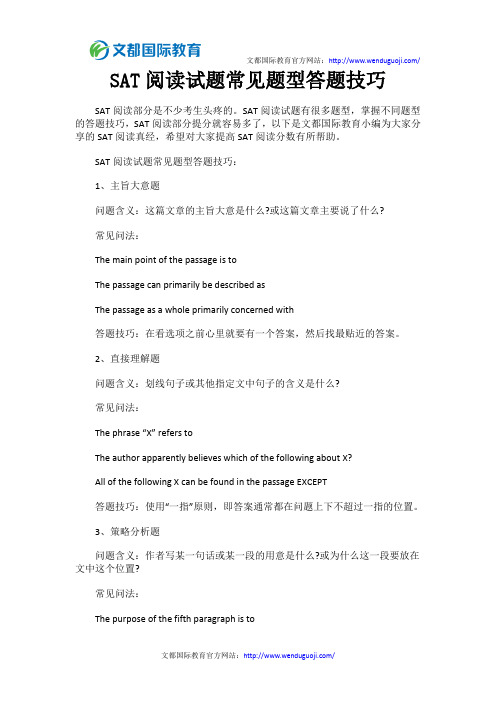
SAT阅读试题常见题型答题技巧SAT阅读部分是不少考生头疼的。
SAT阅读试题有很多题型,掌握不同题型的答题技巧,SAT阅读部分提分就容易多了,以下是文都国际教育小编为大家分享的SAT阅读真经,希望对大家提高SAT阅读分数有所帮助。
SAT阅读试题常见题型答题技巧:1、主旨大意题问题含义:这篇文章的主旨大意是什么?或这篇文章主要说了什么?常见问法:The main point of the passage is toThe passage can primarily be described asThe passage as a whole primarily concerned with答题技巧:在看选项之前心里就要有一个答案,然后找最贴近的答案。
2、直接理解题问题含义:划线句子或其他指定文中句子的含义是什么?常见问法:The phrase “X” refers toThe author apparently believes which of the following about X?All of the following X can be found in the passage EXCEPT答题技巧:使用“一指”原则,即答案通常都在问题上下不超过一指的位置。
3、策略分析题问题含义:作者写某一句话或某一段的用意是什么?或为什么这一段要放在文中这个位置?常见问法:The purpose of the fifth paragraph is toThe author mentions X in order to demonstrateThe quotation marks around X serve to emphasize答题技巧:要么是总结上文,要么是承上启下,或者引出下文。
4、间接推测题问题含义:从文中我们可以推测出什么信息?常见问法:It can be inferred from X thatThe statement in X suggests/implies thatX is based on the assumption that答题技巧:SAT对此类题的答案设置非常保守,并且通常都有文字佐证。
新sat阅读题型技巧
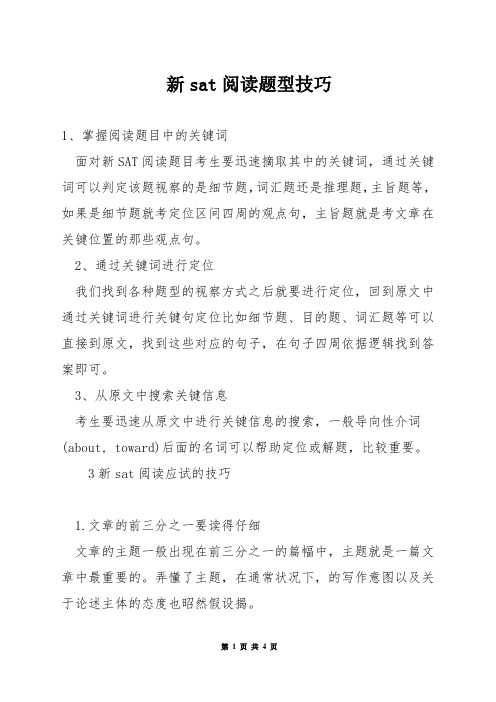
新sat阅读题型技巧1、掌握阅读题目中的关键词面对新SAT阅读题目考生要迅速摘取其中的关键词,通过关键词可以判定该题视察的是细节题,词汇题还是推理题,主旨题等,如果是细节题就考定位区间四周的观点句,主旨题就是考文章在关键位置的那些观点句。
2、通过关键词进行定位我们找到各种题型的视察方式之后就要进行定位,回到原文中通过关键词进行关键句定位比如细节题、目的题、词汇题等可以直接到原文,找到这些对应的句子,在句子四周依据逻辑找到答案即可。
3、从原文中搜索关键信息考生要迅速从原文中进行关键信息的搜索,一般导向性介词(about, toward)后面的名词可以帮助定位或解题,比较重要。
3新sat阅读应试的技巧1.文章的前三分之一要读得仔细文章的主题一般出现在前三分之一的篇幅中,主题就是一篇文章中最重要的。
弄懂了主题,在通常状况下,的写作意图以及关于论述主体的态度也昭然假设揭。
2.注意和文章的简短介绍在SAT阅读中都会提供以及文章的简短介绍,仔细看花费不了多少时间,还可以对文章有大致了解。
是掌握文章谋篇布局和写作目的的主要依据。
SAT考试要求考生能够在考试现场的阅读中理解的思维方式和行文套路哦!3.抓大放小,别总是纠结文章细节每一篇文章中的细节都只是为了说明的思索和描述,所以碰到细节应该跳读,一眼扫过知道什么意思就行了。
很多考生往往希望能够在考试的短短时间内准确理解文章的所有内容,一方面时间有限不太可能,另一方面也没有必要。
4.注意每一段的主题段落实质上是文章的基本组成部分。
所以,考生在阅读SAT文章的时候,应该注意抓住文章每一段的主题,并描述出文章大致上的框架结构。
问自己这样几个问题,可以帮助自己了解主题。
4新sat如何快速提分1.克服生词平常学习过程中除了基本的词汇过关外,在SAT阅读考试中我们不免会碰到很多生词,这些都要总结,都要去掌握,因为这些往往都是SAT考试中的核心词汇,这些词在考试中大有用处。
SAT阅读常见题型及解题技巧

SAT阅读常见题型及解题技巧SAT阅读常见题型及解题技巧SAT阅读题型考察点是多样性的,想要翻越SAT这座大山,了解阅读题型会让我们更快速把握阅读的重点,锁定关键词,更加省时高效的完成篇章阅读。
学会辨认题目的考点,明白题目中究竟是想要考哪一方面。
我们可以将SAT的考点类型分为六类。
一、Main Idea-主旨题1、考察点:考察的是文章的中心思想2、提问方式The main point of the passage is toThe passage is primarily concerned withThe author’s primary purpose in this passage is toThe chief theme of the passage can be best described asWhich of the following titles best describes the content of the passage?Which of the following statements best expresses the main idea of the passage?3、解题技巧在做主旨题的时候,返回原文查看文章的开头和结尾部分。
在阅读文章的时候,注意每一段的首位都是重点部分,这些部分往往是对整段的概括,中心内容,从中往往能很快找到作者的观点。
注意那些连接词,比如:furthermore, moreover, notably, and significantly,这些词的后面往往也会引出文中的主旨。
值得注意的是,SAT文章中一般不会直接给出文章的主旨句,这个时候,小伙伴们可以想想以下几个问题:1) 这篇文章是关于什么的?或者是关于谁的?2) 作者关于这个事物共说了几个方面?3) 作者通过这篇文章想要说明什么?或者是想要告诉读者什么?在做“主旨题”或者是“文章目的”时,要注意以下词汇的表达,都是关于这类题型的提问方式。
SAT阅读考试答题要点全面讲解
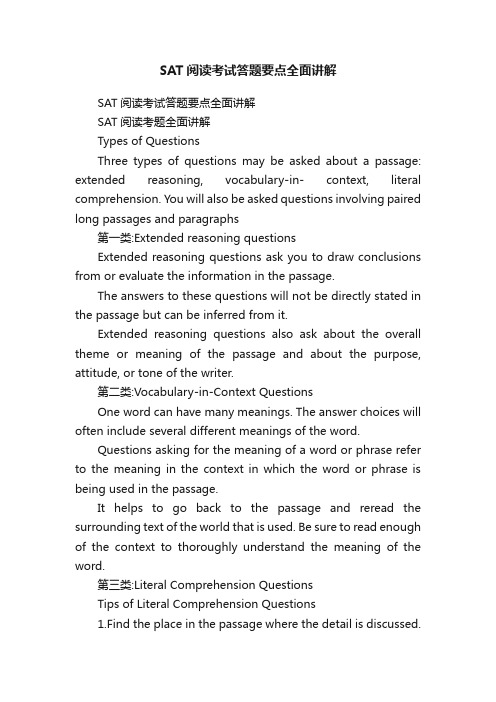
SAT阅读考试答题要点全面讲解SAT阅读考试答题要点全面讲解SAT阅读考题全面讲解Types of QuestionsThree types of questions may be asked about a passage: extended reasoning, vocabulary-in- context, literal comprehension. You will also be asked questions involving paired long passages and paragraphs第一类:Extended reasoning questionsExtended reasoning questions ask you to draw conclusions from or evaluate the information in the passage.The answers to these questions will not be directly stated in the passage but can be inferred from it.Extended reasoning questions also ask about the overall theme or meaning of the passage and about the purpose, attitude, or tone of the writer.第二类:Vocabulary-in-Context QuestionsOne word can have many meanings. The answer choices will often include several different meanings of the word.Questions asking for the meaning of a word or phrase refer to the meaning in the context in which the word or phrase is being used in the passage.It helps to go back to the passage and reread the surrounding text of the world that is used. Be sure to read enough of the context to thoroughly understand the meaning of the word.第三类:Literal Comprehension QuestionsTips of Literal Comprehension Questions1.Find the place in the passage where the detail is discussed.2.Recognize different ways of stating the same fact or idea.3.Cross out incorrect responses as you eliminate them.4.Read questions carefully, looking for words such as except, not, and only, and for other words that describe exactly what you are asked to do with the information.5.Be sure you can support your answer by referring to words or phrases within the passage that support it.第四类:Questions Involving Paired Passages and Paragraphs The pair of passages will have a common theme or subject.One of the passages will oppose, support, or in some way relate to the other. (反对,支持,或相关)SAT阅读题解题要点Remember, every word counts.Read the questions and answers carefully.Don't forget that an answer choice can be both true and wrong. The correct choice is the one that best answers the question, not any choice that makes a true statement.Make sure the reading passage supports your answer. Try eliminating choices. Double-check the other choices. Don't jump from passage to passage.。
SAT阅读题技巧整理
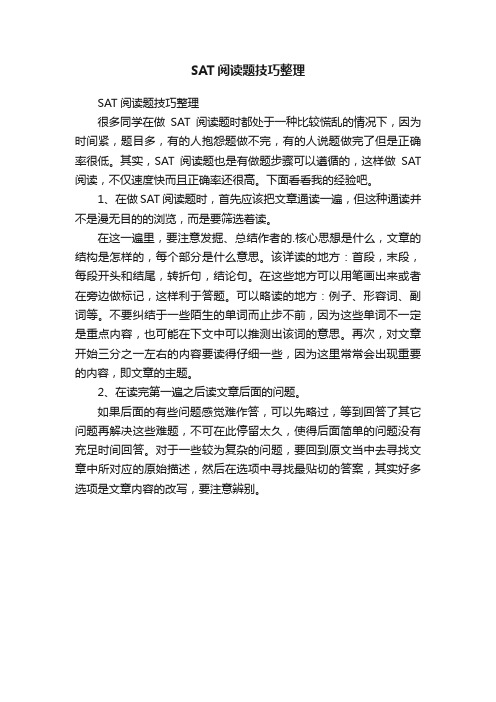
SAT阅读题技巧整理
SAT阅读题技巧整理
很多同学在做SAT阅读题时都处于一种比较慌乱的情况下,因为时间紧,题目多,有的人抱怨题做不完,有的人说题做完了但是正确率很低。
其实,SAT阅读题也是有做题步骤可以遵循的,这样做SAT 阅读,不仅速度快而且正确率还很高。
下面看看我的经验吧。
1、在做SAT阅读题时,首先应该把文章通读一遍,但这种通读并不是漫无目的的浏览,而是要筛选着读。
在这一遍里,要注意发掘、总结作者的.核心思想是什么,文章的结构是怎样的,每个部分是什么意思。
该详读的地方:首段,末段,每段开头和结尾,转折句,结论句。
在这些地方可以用笔画出来或者在旁边做标记,这样利于答题。
可以略读的地方:例子、形容词、副词等。
不要纠结于一些陌生的单词而止步不前,因为这些单词不一定是重点内容,也可能在下文中可以推测出该词的意思。
再次,对文章开始三分之一左右的内容要读得仔细一些,因为这里常常会出现重要的内容,即文章的主题。
2、在读完第一遍之后读文章后面的问题。
如果后面的有些问题感觉难作答,可以先略过,等到回答了其它问题再解决这些难题,不可在此停留太久,使得后面简单的问题没有充足时间回答。
对于一些较为复杂的问题,要回到原文当中去寻找文章中所对应的原始描述,然后在选项中寻找最贴切的答案,其实好多选项是文章内容的改写,要注意辨别。
SAT阅读主旨题和细节题答题技巧
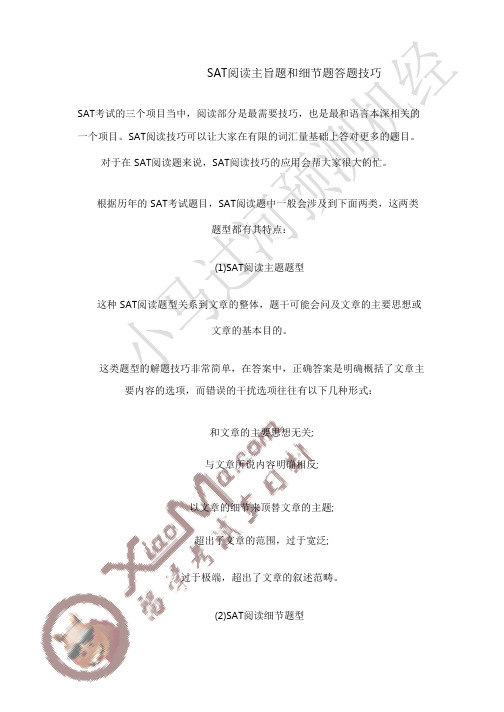
SAT阅读主旨题和细节题答题技巧SAT考试的三个项目当中,阅读部分是最需要技巧,也是最和语言本深相关的一个项目。
SAT阅读技巧可以让大家在有限的词汇量基础上答对更多的题目。
对于在 SAT阅读题来说,SAT阅读技巧的应用会帮大家很大的忙。
根据历年的 SAT考试题目,SAT阅读题中一般会涉及到下面两类,这两类题型都有其特点:(1)SAT阅读主题题型这种 SAT阅读题型关系到文章的整体,题干可能会问及文章的主要思想或文章的基本目的。
这类题型的解题技巧非常简单,在答案中,正确答案是明确概括了文章主要内容的选项,而错误的干扰选项往往有以下几种形式:和文章的主要思想无关;与文章所说内容明确相反;以文章的细节来顶替文章的主题;超出了文章的范围,过于宽泛;过于极端,超出了文章的叙述范畴。
(2)SAT阅读细节题型这种题型往往是问到了文章当中的某一环节的具体内容,在做这类题目时,考生一般都必须回到原文关于该问题的叙述之处,来寻找正确答案的源头。
SAT阅读细节题型的解题技巧和主题题型不同,大家在挑选干扰项的标准也不一样。
细节题型的干扰选项一般有以下几种形式:以文章其它地方的叙述来混淆视听;使用了与原文相近的词汇,但却歪曲了原文的意思;与原文的叙述相矛盾;所说的内容在原文中并没有表述出来,而且也不能从原文的逻辑推导出来;使用了极端化的叙述。
以上就是对 SAT阅读题的解题技巧的一个梳理,包括了 SAT阅读考试中的两个非常重要的题型。
大家可以在自己的 SAT阅读考试备考过程中,根据上面所列出来的选项的特点进行更加有针对性的练习。
最后祝大家考试顺利。
SAT阅读题型及解题技巧
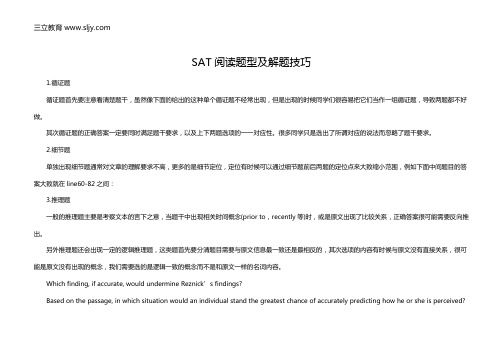
SAT阅读题型及解题技巧1.循证题循证题首先要注意看清楚题干,虽然像下面的给出的这种单个循证题不经常出现,但是出现的时候同学们很容易把它们当作一组循证题,导致两题都不好做。
其次循证题的正确答案一定要同时满足题干要求,以及上下两题选项的一一对应性。
很多同学只是选出了所谓对应的说法而忽略了题干要求。
2.细节题单独出现细节题通常对文章的理解要求不高,更多的是细节定位,定位有时候可以通过细节题前后两题的定位点来大致缩小范围,例如下面中间题目的答案大致就在line60-82之间:3.推理题一般的推理题主要是考察文本的言下之意,当题干中出现相关时间概念(prior to,recently等)时,或是原文出现了比较关系,正确答案很可能需要反向推出。
另外推理题还会出现一定的逻辑推理题,这类题首先要分清题目需要与原文信息最一致还是最相反的,其次选项的内容有时候与原文没有直接关系,很可能是原文没有出现的概念,我们需要选的是逻辑一致的概念而不是和原文一样的名词内容。
Which finding, if accurate, would undermine Reznick’s findings?Based on the passage, in which situation would an individual stand the greatest chance of accurately predicting how he or she is perceived?4.目的题首先我们要明确目的考察作者写作意图而不是定位点的字面意思。
其次在处理目的题时,注意把定位点及其前后的内容一起看完,因为正确答案更容易出现在定位点前后。
例如下面这题,题干给出定位点在line17-18,正确答案则需要从定位点前面推出:5.词汇题词汇题主要就是抓住两点,词汇本身及其上下文。
在考虑上下文时注意运用搭配法(主谓宾,名词与形容词,态度一致)或者句子平行结构(多出现于分句)。
SAT文学作品阅读技巧及解答

SAT文学作品阅读技巧及解答
SAT文学作品阅读技巧及解答
下面是关于SAT阅读考试中文学作品的`解答方法。
文学作品在SAT阅读考试中所占的比重很大,而且难度也相对比较大,对考生的要求比较高。
SAT阅读考试中,文学作品包括了novel, memoir, story, narratives, essay, etc.
关于文学作品的SAT答题方法:
① 通过导言识别文章类型
② 先看某个题目
③ 再看相应的文章内容
④ 排查选项作答
⑤ 重复②--④完成其他题目
注意:两个问题中间的其余内容最好快速浏览,不要跳过不读
Solution to literature
① identify the type of the passage by scanning the intro
② scrutinize a question
③ read the content of the passage relating to the question carefully
④ choose the best answer for it
⑤ repeat
Note: for the content between two successive questions, dont skip but scan quickly
建议:因为文学作品的文章行文比较难懂,阅读又比较耗时,所以答题的时候可以置后做。
【SAT文学作品阅读技巧及解答】。
sat短篇阅读分析与技巧
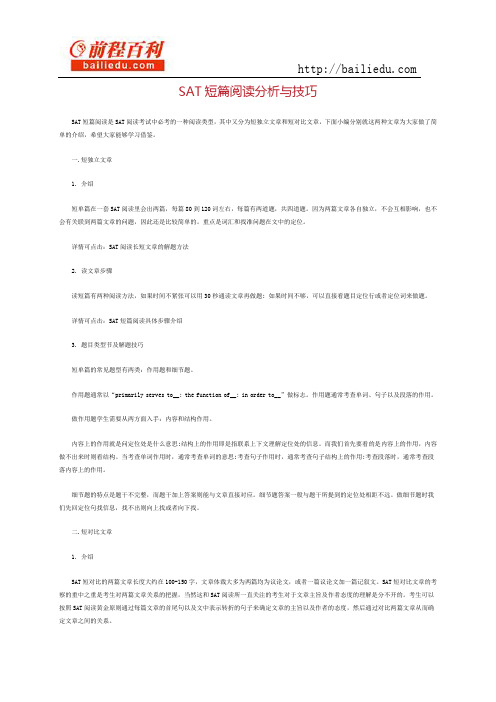
SAT短篇阅读分析与技巧SAT短篇阅读是SAT阅读考试中必考的一种阅读类型,其中又分为短独立文章和短对比文章,下面小编分别就这两种文章为大家做了简单的介绍,希望大家能够学习借鉴。
一.短独立文章1. 介绍短单篇在一套SAT阅读里会出两篇,每篇80到120词左右,每篇有两道题,共四道题。
因为两篇文章各自独立,不会互相影响,也不会有关联到两篇文章的问题,因此还是比较简单的。
重点是词汇和找准问题在文中的定位。
详情可点击:SAT阅读长短文章的解题方法2. 读文章步骤读短篇有两种阅读方法,如果时间不紧张可以用30秒通读文章再做题; 如果时间不够,可以直接看题目定位行或者定位词来做题。
详情可点击:SAT短篇阅读具体步骤介绍3. 题目类型节及解题技巧短单篇的常见题型有两类:作用题和细节题。
作用题通常以“primarily serves to__; the function of__; in order to__”做标志。
作用题通常考查单词、句子以及段落的作用。
做作用题学生需要从两方面入手:内容和结构作用。
内容上的作用就是问定位处是什么意思;结构上的作用即是指联系上下文理解定位处的信息。
而我们首先要看的是内容上的作用,内容做不出来时则看结构。
当考查单词作用时,通常考查单词的意思;考查句子作用时,通常考查句子结构上的作用;考查段落时,通常考查段落内容上的作用。
细节题的特点是题干不完整,而题干加上答案则能与文章直接对应。
细节题答案一般与题干所提到的定位处相距不远。
做细节题时我们先回定位句找信息,找不出则向上找或者向下找。
二.短对比文章1. 介绍SAT短对比的两篇文章长度大约在100-150字,文章体裁大多为两篇均为议论文,或者一篇议论文加一篇记叙文。
SAT短对比文章的考察的重中之重是考生对两篇文章关系的把握,当然这和SAT阅读所一直关注的考生对于文章主旨及作者态度的理解是分不开的。
考生可以按照SAT阅读黄金原则通过每篇文章的首尾句以及文中表示转折的句子来确定文章的主旨以及作者的态度,然后通过对比两篇文章从而确定文章之间的关系。
如何阅读说明文?SAT阅读说明文例题解析
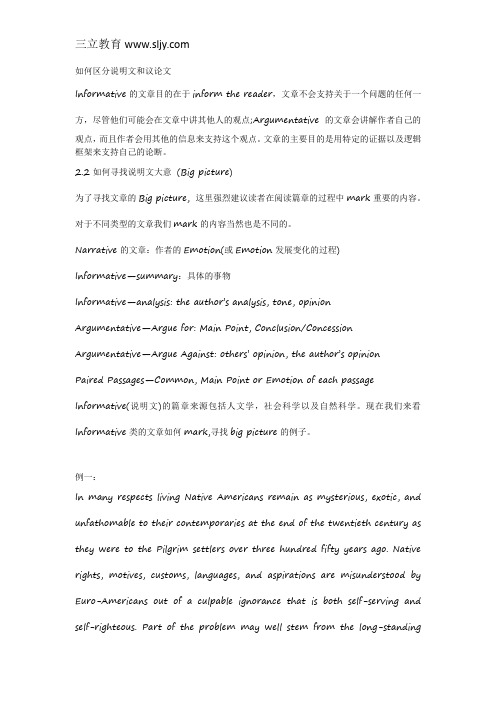
如何区分说明文和议论文Informative的文章目的在于inform the reader,文章不会支持关于一个问题的任何一方,尽管他们可能会在文章中讲其他人的观点;Argumentative的文章会讲解作者自己的观点,而且作者会用其他的信息来支持这个观点。
文章的主要目的是用特定的证据以及逻辑框架来支持自己的论断。
2.2如何寻找说明文大意(Big picture)为了寻找文章的Big picture, 这里强烈建议读者在阅读篇章的过程中mark重要的内容。
对于不同类型的文章我们mark的内容当然也是不同的。
Narrative的文章:作者的Emotion(或Emotion发展变化的过程) Informative—summary:具体的事物Informative—analysis: the author‟s analysis, tone, opinion Argumentative—Argue for: Main Point, Conclusion/Concession Argumentative—Arg ue Against: others‟ opinion, the author‟s opinionPaired Passages—Common, Main Point or Emotion of each passage Informative(说明文)的篇章来源包括人文学,社会科学以及自然科学。
现在我们来看Informative类的文章如何mark,寻找big picture的例子。
例一:In many respects living Native Americans remain as mysterious, exotic, and unfathomable to their contemporaries at the end of the twentieth century as they were to the Pilgrim settlers over three hundred fifty years ago. Native rights, motives, customs, languages, and aspirations are misunderstood by Euro-Americans out of a culpable ignorance that is both self-serving and self-righteous. Part of the problem may well stem from the long-standingtendency of European or Euro-American thinkers to regard Native Americans as fundamentally and profoundly different, motivated more often by mysticism than by ambition, charged more by unfathomable visions than by intelligence or introspection.This idea is certainly not new. Rousseau‟s* “noble savages” wandered, pure of heart, through a pristine world. Since native people were simply assumed to be incomprehensible, they were seldom comprehended. Their societies were simply beheld, often through cloudy glasses, and rarely probed by the tools of logic and deductive analysis automatically reserved for cultures prejudged to be “civilized.” And on those occasions when Europeans did attempt to formulate an encompassing theory, it was not, ordinarily, on a human-being-to-human-being basis, but rather through an ancestor-descendant model. Native Americans, though obviously contemporary with their observers, were somehow regarded as ancient, examples of what Stone Age Europeans must have been like.It‟s a great story, an international crowd pleaser, but there is a difficulty: Native Americans were, and are, Homo sapiens sapiens. Though often equipped with a shovel-shaped incisor tooth, eyes with epicanthic folds, or an extra molar cusp, Native American people have had to cope, for the last forty thousand years or so, just like everyone else. Their cultures have had to make internal sense, their medicines have had to work consistently and practically, their philosophical explanations have had to be reasonably satisfying anddependable, or else the ancestors of those now called Native Americans would truly have vanished long ago.The reluctance in accepting this obvious fact comes from the Eurocentric conviction that the West holds a monopoly on science, logic, and clear thinking. To admit that other, culturally divergent viewpoints are equally plausible is to cast doubt on the monolithic center of Judeo-Christian belief: that there is but one of everything—God, right way, truth—and Europeans alone knew what that was. If Native American cultures were acknowledged as viable, then European societies were something less than an exclusive club. It is little wonder, therefore, that Native Americans were perceived not so much as they were but as they had to be, from a European viewpoint. They dealt in magic, not method. They were stuck in their past, not guided by its precedents. Such expedient misconception argues strongly for the development and dissemination of a more accurate, more objective historical account of native peoples—a goal easier stated than accomplished. Native American societies were nonliterate before and during much of the early period of their contact with Europe, making the task of piecing together a history particularly demanding. The familiar and reassuring kinds of written documentation found in European societies of equivalent chronological periods do not exist, and the forms of tribal record preservation available—oral history, tales, mnemonic devices, and religious rituals— strike university-trained academics as inexact, unreliable, and suspect. Western historians, culture-bound by their ownapproach to knowledge, are apt to declaim that next to nothing, save the evidence of archaeology, can be known of early Native American life. To them, an absolute void is more acceptable and rigorous than an educated guess. However, it is naïve to assume that any culture‟s history is p erceived without subjective prejudice. Every modern observer, whether he or she was schooled in the traditions of the South Pacific or Zaire, of Hanover, New Hampshire, or Vienna, Austria, was exposed at an early age to one or another form of folklore about Native Americans. For some, the very impressions about Native American tribes that initially attracted them to the field of American history are aspects most firmly rooted in popular myth and stereotype. Serious scholarship about Native American culture and history is unique in that it requires an initial, abrupt, and wrenching demythologizing. Most students do not start from point zero, but from minus zero, and in the process are often required to abandon cherished childhood fantasies of superheroes or larger-than-life villains.读者可以自行用3分钟的时间来寻找一下这篇文章的Big picture。
sat阅读题型解题技巧
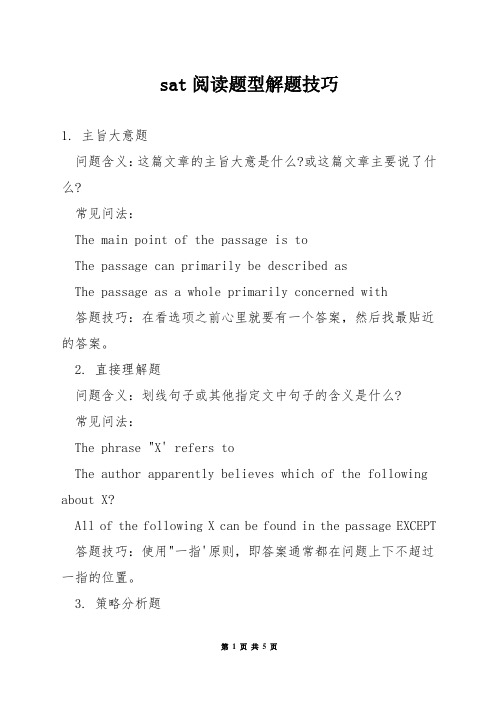
sat阅读题型解题技巧1. 主旨大意题问题含义:这篇文章的主旨大意是什么?或这篇文章主要说了什么?常见问法:The main point of the passage is toThe passage can primarily be described asThe passage as a whole primarily concerned with 答题技巧:在看选项之前心里就要有一个答案,然后找最贴近的答案。
2. 直接理解题问题含义:划线句子或其他指定文中句子的含义是什么?常见问法:The phrase "X' refers toThe author apparently believes which of the following about X?All of the following X can be found in the passage EXCEPT 答题技巧:使用"一指'原则,即答案通常都在问题上下不超过一指的位置。
3. 策略分析题问题含义:写某一句话或某一段的用意是什么?或为什么这一段要放在文中这个位置?常见问法:The purpose of the fifth paragraph is toThe author mentions X in order to demonstrateThe quotation marks around X serve to emphasize 答题技巧:要么是总结上文,要么是承上启下,或者引出下文。
2sat考试冲刺技巧1、梳理之前做过的题目,迅速找回之前做题的感觉很多同学前面考试后就没有怎么做过题目了,另外又经历了学校期末考试,关于考试的熟悉度大大降低,这样完全比不上暑假集中学习之后去考试来的感觉好。
那么这时候可以集中时间回忆一下之前做过的所有题目,调动起之前做题的感觉为第一步。
2、回忆分析错题集中时间进行错题分析整理,找到错题原因,并发现自己的易错点,再结合同类题目进行强化学习。
如何阅读说明文?SAT阅读说明文例题解析
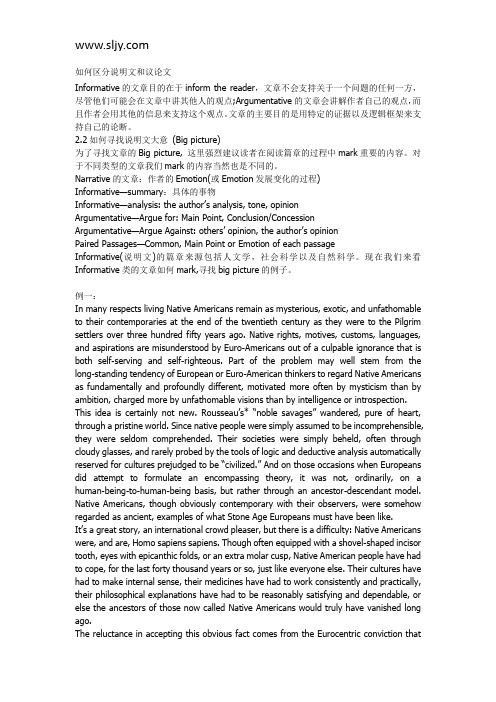
如何区分说明文和议论文Informative的文章目的在于inform the reader,文章不会支持关于一个问题的任何一方,尽管他们可能会在文章中讲其他人的观点;Argumentative的文章会讲解作者自己的观点,而且作者会用其他的信息来支持这个观点。
文章的主要目的是用特定的证据以及逻辑框架来支持自己的论断。
2.2如何寻找说明文大意(Big picture)为了寻找文章的Big picture, 这里强烈建议读者在阅读篇章的过程中mark重要的内容。
对于不同类型的文章我们mark的内容当然也是不同的。
Narrative的文章:作者的Emotion(或Emotion发展变化的过程) Informative—summary:具体的事物Informative—analysis: the author‟s analysis, tone, opinionArgumentative—Argue for: Main Point, Conclusion/ConcessionArgumentative—Arg ue Against: others‟ opinion, the author‟s opinionPaired Passages—Common, Main Point or Emotion of each passageInformative(说明文)的篇章来源包括人文学,社会科学以及自然科学。
现在我们来看Informative类的文章如何mark,寻找big picture的例子。
例一:In many respects living Native Americans remain as mysterious, exotic, and unfathomable to their contemporaries at the end of the twentieth century as they were to the Pilgrim settlers over three hundred fifty years ago. Native rights, motives, customs, languages, and aspirations are misunderstood by Euro-Americans out of a culpable ignorance that is both self-serving and self-righteous. Part of the problem may well stem from the long-standing tendency of European or Euro-American thinkers to regard Native Americans as fundamentally and profoundly different, motivated more often by mysticism than by ambition, charged more by unfathomable visions than by intelligence or introspection. This idea is certainly not new. Rousseau‟s* “noble savages” wandered, pure of heart, through a pristine world. Since native people were simply assumed to be incomprehensible, they were seldom comprehended. Their societies were simply beheld, often through cloudy glasses, and rarely probed by the tools of logic and deductive analysis automatically reserved for cultures prejudged to be “civilized.” And on those occasions when Europeans did attempt to formulate an encompassing theory, it was not, ordinarily, on a human-being-to-human-being basis, but rather through an ancestor-descendant model. Native Americans, though obviously contemporary with their observers, were somehow regarded as ancient, examples of what Stone Age Europeans must have been like.It‟s a great story, an international crowd pleaser, but there is a difficulty: Native Americans were, and are, Homo sapiens sapiens. Though often equipped with a shovel-shaped incisor tooth, eyes with epicanthic folds, or an extra molar cusp, Native American people have had to cope, for the last forty thousand years or so, just like everyone else. Their cultures have had to make internal sense, their medicines have had to work consistently and practically, their philosophical explanations have had to be reasonably satisfying and dependable, or else the ancestors of those now called Native Americans would truly have vanished long ago.The reluctance in accepting this obvious fact comes from the Eurocentric conviction thatthe West holds a monopoly on science, logic, and clear thinking. To admit that other, culturally divergent viewpoints are equally plausible is to cast doubt on the monolithic center of Judeo-Christian belief: that there is but one of everything—God, right way, truth—and Europeans alone knew what that was. If Native American cultures were acknowledged as viable, then European societies were something less than an exclusive club. It is little wonder, therefore, that Native Americans were perceived not so much as they were but as they had to be, from a European viewpoint. They dealt in magic, not method. They were stuck in their past, not guided by its precedents.Such expedient misconception argues strongly for the development and dissemination of a more accurate, more objective historical account of native peoples—a goal easier stated than accomplished. Native American societies were nonliterate before and during much of the early period of their contact with Europe, making the task of piecing together a history particularly demanding. The familiar and reassuring kinds of written documentation found in European societies of equivalent chronological periods do not exist, and the forms of tribal record preservation available—oral history, tales, mnemonic devices, and religious rituals— strike university-trained academics as inexact, unreliable, and suspect. Western historians, culture-bound by their own approach to knowledge, are apt to declaim that next to nothing, save the evidence of archaeology, can be known of early Native American life. To them, an absolute void is more acceptable and rigorous than an educated guess. However, it is naïve to assume that any culture‟s history is p erceived without subjective prejudice. Every modern observer, whether he or she was schooled in the traditions of the South Pacific or Zaire, of Hanover, New Hampshire, or Vienna, Austria, was exposed at an early age to one or another form of folklore about Native Americans. For some, the very impressions about Native American tribes that initially attracted them to the field of American history are aspects most firmly rooted in popular myth and stereotype. Serious scholarship about Native American culture and history is unique in that it requires an initial, abrupt, and wrenching demythologizing. Most students do not start from point zero, but from minus zero, and in the process are often required to abandon cherished childhood fantasies of superheroes or larger-than-life villains.读者可以自行用3分钟的时间来寻找一下这篇文章的Big picture。
SAT文章阅读十大答题技巧
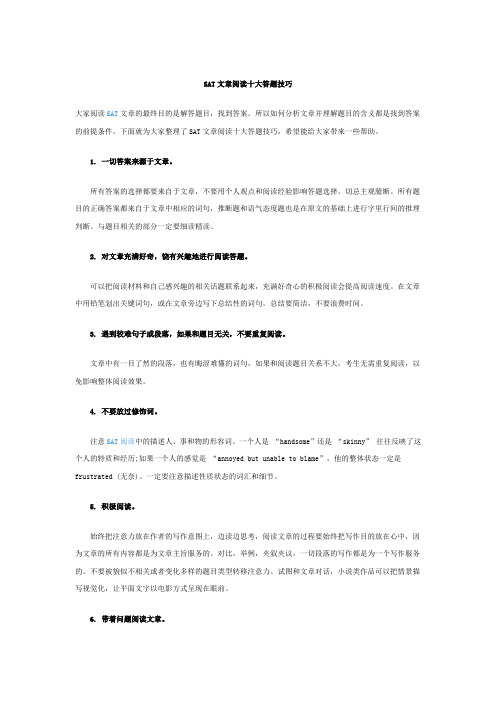
SAT文章阅读十大答题技巧大家阅读SAT文章的最终目的是解答题目,找到答案。
所以如何分析文章并理解题目的含义都是找到答案的前提条件。
下面就为大家整理了SAT文章阅读十大答题技巧,希望能给大家带来一些帮助。
1. 一切答案来源于文章。
所有答案的选择都要来自于文章,不要用个人观点和阅读经验影响答题选择。
切忌主观臆断。
所有题目的正确答案都来自于文章中相应的词句,推断题和语气态度题也是在原文的基础上进行字里行间的推理判断。
与题目相关的部分一定要细读精读。
2. 对文章充满好奇,饶有兴趣地进行阅读答题。
可以把阅读材料和自己感兴趣的相关话题联系起来,充满好奇心的积极阅读会提高阅读速度。
在文章中用铅笔划出关键词句,或在文章旁边写下总结性的词句。
总结要简洁,不要浪费时间。
3. 遇到较难句子或段落,如果和题目无关,不要重复阅读。
文章中有一目了然的段落,也有晦涩难懂的词句,如果和阅读题目关系不大,考生无需重复阅读,以免影响整体阅读效果。
4. 不要放过修饰词。
注意SAT阅读中的描述人、事和物的形容词。
一个人是“handsome”还是“skinny”往往反映了这个人的特质和经历;如果一个人的感觉是“annoyed but unable to blame”,他的整体状态一定是frustrated (无奈)。
一定要注意描述性质状态的词汇和细节。
5. 积极阅读。
始终把注意力放在作者的写作意图上,边读边思考,阅读文章的过程要始终把写作目的放在心中,因为文章的所有内容都是为文章主旨服务的。
对比,举例,夹叙夹议,一切段落的写作都是为一个写作服务的。
不要被貌似不相关或者变化多样的题目类型转移注意力。
试图和文章对话,小说类作品可以把情景描写视觉化,让平面文字以电影方式呈现在眼前。
6. 带着问题阅读文章。
细节问题可以先看题再看文章相应内容,问题题目一定要准确完整阅读,然后从文中寻找可以回答题目的相应关键词,然后根据原文线索寻找对应正确选项。
SAT阅读考试答题方法解读
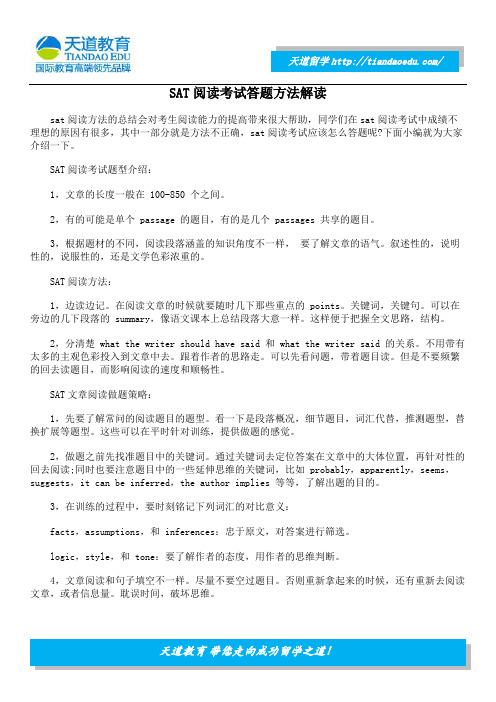
SAT阅读考试答题方法解读sat阅读方法的总结会对考生阅读能力的提高带来很大帮助,同学们在sat阅读考试中成绩不理想的原因有很多,其中一部分就是方法不正确,sat阅读考试应该怎么答题呢?下面小编就为大家介绍一下。
SAT阅读考试题型介绍:1,文章的长度一般在 100-850 个之间。
2,有的可能是单个 passage 的题目,有的是几个 passages 共享的题目。
3,根据题材的不同,阅读段落涵盖的知识角度不一样,要了解文章的语气。
叙述性的,说明性的,说服性的,还是文学色彩浓重的。
SAT阅读方法:1,边读边记。
在阅读文章的时候就要随时几下那些重点的 points。
关键词,关键句。
可以在旁边的几下段落的 summary,像语文课本上总结段落大意一样。
这样便于把握全文思路,结构。
2,分清楚 what the writer should have said 和 what the writer said 的关系。
不用带有太多的主观色彩投入到文章中去。
跟着作者的思路走。
可以先看问题,带着题目读。
但是不要频繁的回去读题目,而影响阅读的速度和顺畅性。
SAT文章阅读做题策略:1,先要了解常问的阅读题目的题型。
看一下是段落概况,细节题目,词汇代替,推测题型,替换扩展等题型。
这些可以在平时针对训练,提供做题的感觉。
2,做题之前先找准题目中的关键词。
通过关键词去定位答案在文章中的大体位置,再针对性的回去阅读;同时也要注意题目中的一些延伸思维的关键词,比如 probably,apparently,seems,suggests,it can be inferred,the author implies 等等,了解出题的目的。
3,在训练的过程中,要时刻铭记下列词汇的对比意义:facts,assumptions,和 inferences:忠于原文,对答案进行筛选。
logic,style,和 tone:要了解作者的态度,用作者的思维判断。
SAT阅读中几种比较常见的题型解题技巧
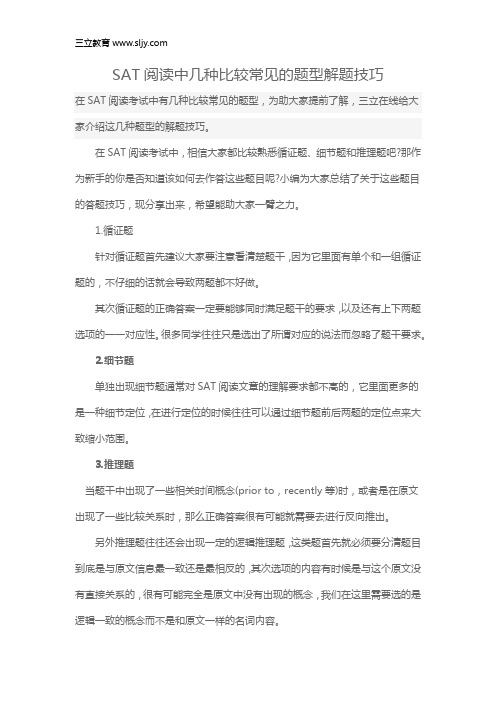
三立教育
SAT阅读中几种比较常见的题型解题技巧
在SAT阅读考试中有几种比较常见的题型,为助大家提前了解,三立在线给大家介绍这几种题型的解题技巧。
在SAT阅读考试中,相信大家都比较熟悉循证题、细节题和推理题吧?那作为新手的你是否知道该如何去作答这些题目呢?小编为大家总结了关于这些题目的答题技巧,现分享出来,希望能助大家一臂之力。
1.循证题
针对循证题首先建议大家要注意看清楚题干,因为它里面有单个和一组循证题的,不仔细的话就会导致两题都不好做。
其次循证题的正确答案一定要能够同时满足题干的要求,以及还有上下两题选项的一一对应性。
很多同学往往只是选出了所谓对应的说法而忽略了题干要求。
2.细节题
单独出现细节题通常对SAT阅读文章的理解要求都不高的,它里面更多的是一种细节定位,在进行定位的时候往往可以通过细节题前后两题的定位点来大致缩小范围。
3.推理题
当题干中出现了一些相关时间概念(prior to,recently等)时,或者是在原文出现了一些比较关系时,那么正确答案很有可能就需要去进行反向推出。
另外推理题往往还会出现一定的逻辑推理题,这类题首先就必须要分清题目到底是与原文信息最一致还是最相反的,其次选项的内容有时候是与这个原文没有直接关系的,很有可能完全是原文中没有出现的概念,我们在这里需要选的是逻辑一致的概念而不是和原文一样的名词内容。
新SAT阅读题型以及解题思路解读
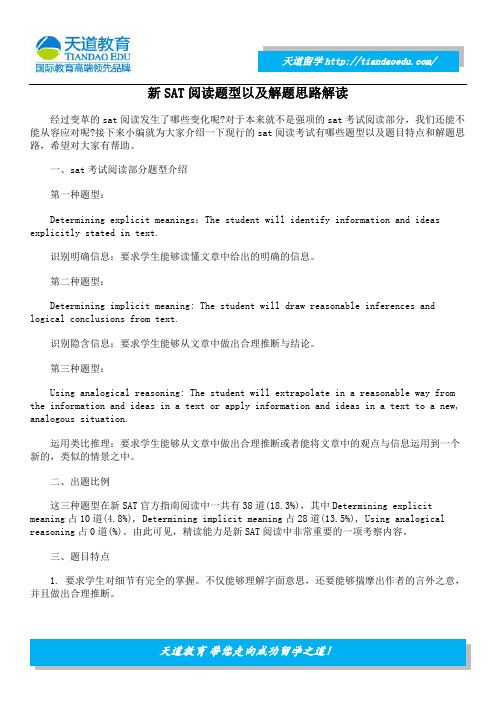
新SAT阅读题型以及解题思路解读经过变革的sat阅读发生了哪些变化呢?对于本来就不是强项的sat考试阅读部分,我们还能不能从容应对呢?接下来小编就为大家介绍一下现行的sat阅读考试有哪些题型以及题目特点和解题思路,希望对大家有帮助。
一、sat考试阅读部分题型介绍第一种题型:Determining explicit meanings:The student will identify information and ideas explicitly stated in text.识别明确信息:要求学生能够读懂文章中给出的明确的信息。
第二种题型:Determining implicit meaning: The student will draw reasonable inferences and logical conclusions from text.识别隐含信息:要求学生能够从文章中做出合理推断与结论。
第三种题型:Using analogical reasoning: The student will extrapolate in a reasonable way from the information and ideas in a text or apply information and ideas in a text to a new, analogous situation.运用类比推理:要求学生能够从文章中做出合理推断或者能将文章中的观点与信息运用到一个新的,类似的情景之中。
二、出题比例这三种题型在新SAT官方指南阅读中一共有38道(18.3%),其中Determining explicit meaning占10道(4.8%), Determining implicit meaning占28道(13.5%), Using analogical reasoning占0道(%)。
由此可见,精读能力是新SAT阅读中非常重要的一项考察内容。
SAT文章阅读题型答题方法
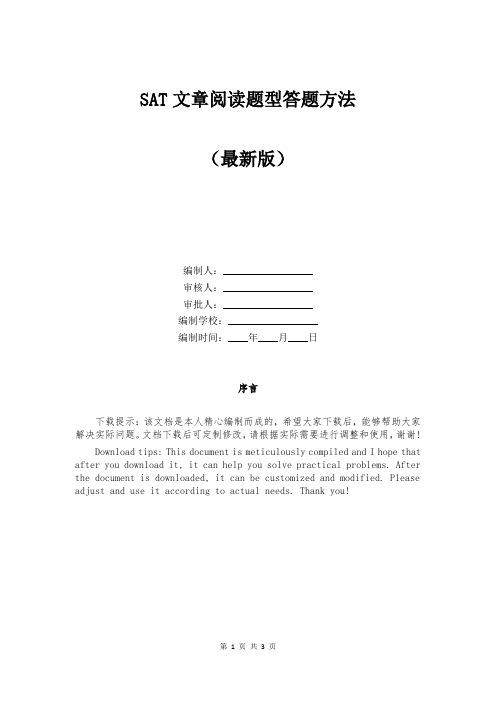
SAT文章阅读题型答题方法(最新版)编制人:__________________审核人:__________________审批人:__________________编制学校:__________________编制时间:____年____月____日序言下载提示:该文档是本人精心编制而成的,希望大家下载后,能够帮助大家解决实际问题。
文档下载后可定制修改,请根据实际需要进行调整和使用,谢谢!Download tips: This document is meticulously compiled and I hope that after you download it, it can help you solve practical problems. After the document is downloaded, it can be customized and modified. Please adjust and use it according to actual needs. Thank you!SAT文章阅读题型答题方法SAT阅读部分每道选择题都结合所阅读的文章,通常涉及的问题类型包括:本篇文章的主要观点及中心主题;在本篇文章中,作者对所论述问题的态度及基本观点;判断所阅读文章的体裁形式,例如:议论、寓言、科技、历史、讽刺、悲剧、喜剧、浪漫、科幻、恐怖、写实及诗歌;作者在文章中所用的修辞手法的目的,在这篇文章中作者希望达到些什么;作者通过特例、类比及比较想要说明些什么等等;什么是文章中的基本事实;阅读材料的含义或暗指是什么;难词、偏词、怪词及多义词在这篇文章中的准确意思是什么等等。
每一篇文章均有其主要观点或中心主题。
典型的`围绕文章主要观点的问题大多是:在这篇文章中作者的主要目的是什么,这篇文章主要涉及什么问题,这篇文章主要建议是什么,这篇文章总体上想要回答什么问题等。
建议考生参考如下几种答题方法:首先快速浏览所有的所问问题,之后再有重点、有目的地通读全文;对总结性、结论性、观点性及重要性的句子要特别注意,做出标识,在这类句子当中常常存在考题的答案;在文章的第一段中,寻找文章的主要观点,同时对比文章的最后一段或接近文章结束的句子中所表述的中心思想,得出本文作者的基本观点;考生在快速通读文章后,若无法一次性确定文章的中心主题,则需依据所问问题分段落、有重点地深入阅读。
- 1、下载文档前请自行甄别文档内容的完整性,平台不提供额外的编辑、内容补充、找答案等附加服务。
- 2、"仅部分预览"的文档,不可在线预览部分如存在完整性等问题,可反馈申请退款(可完整预览的文档不适用该条件!)。
- 3、如文档侵犯您的权益,请联系客服反馈,我们会尽快为您处理(人工客服工作时间:9:00-18:30)。
结构阅读 综合提高速度
区分重要级和优先级,SAT阅读非常重视逻辑和结构,清楚每个段 落的主旨,不同段落之间的逻辑关系非常重要。
用一句话概括一个段落,最后用一句话概括整个文章。使用不同标记 区分重读部分、可略读位置。
science & social science
扫读获取主旨
可跳读的内容 例子、类比、比喻等服务于总结和归纳的部分 插入成分
science & social science
标题&引言—预判
This passage is adapted from Geoffrey Giller, “Long a Mystery, How 500-Meter-High Undersea Waves Form Is Revealed.”
Passage 1 is adapted from Randall J. Hunt, “Do Created Wetlands Replace the Wetlands that are Destroyed?” Passage 2 is adapted from T.M. Lee, K.H. Haag, P.A. Metz, and L.A. Sacks, “Comparative Hydrology, Water Quality, and Ecology of Selected Natural and Augmented Freshwater Wetlands in West-Central Florida.”
Purpose Data source; subject Alteration Control Findings; verdict 逻辑: comparison/contrast
2 experiments /Different times Possible-sure; propose-confirm; speculation-verification But/however Emphasis
Alteration Martone didn’t set out to locate lignin in algae. The biomechanist simply wanted to better understand the toughness of C. cheilosporioides, which dwells in the harsh habitat of intertidal zones along rocky shores…When collaborator Jose Estevez at the Carnegie Institution for Science examined the joints for Martone with a transmission electron microscope, he saw secondary cell walls, features commonly found in land plants. That prompted them to seek out experts in lignin…
SAT--Reading
Introduction
7:45 8:15 8:25 9:00-10:05 10:05-10:15 10:15-10:50 10:50-11:15 11:15-11:20 11:20-12:15 12:15-12:20 12:20-13:10
SAT Test 进场 宣读考试规则 填写个人信息 阅读 休息 语法 数学/不用计算器 休息 数学/计算器 休息 作文
Alteration Ken settled on the Chukar Partridge as a model species, but he might not have made his discovery without a key piece of advice from the local rancher in Montana who was supplying him with birds. When the cowboy stopped by to see how things were going, Ken showed him his nice, tidy laboratory setup and explained how the birds’ first hops and flights would be measured. The rancher was incredulous.“He took one look and said, in pretty colorful language, ‘What are those birds doing on the ground? They hate to be on the ground! Give them something to climb on!’ ” …So he…
让步语气 让步后必有转折,以转折内容为主
表示原因解释的内容 重点是中心句,结论或者作者的态度
He was a moral philosopher who believed sympathy for others was the basis for ethics (we would call it empathy nowadays). But one of his key insights in The Wealth of Nations was that acting on this empathy could be counterproductive—he observed people becoming better off when they put their own empathy aside, and interacted in a self-interested way. [og-p2]
5min reading 8 min answering
Types of Passage
science & social science
术语 主要术语 术语特征 术语关系
结构 提出问题 实证研究 反对意见 让步/排他 解决问题
考点 观点 逻辑 细节 数据
science
术语: Names; terms; newly-introduced words 实验:
Data source; subject they chose as their subject the herb Mimosa pudica, often known as the touch-me-not because its leaves fold swiftly inwards when disturbed—a mechanism designed to defend it against predators.
顺接连词后的部分/列举部分/单独出现的数字 In addition, moreover, also, further
Last year, Americans spent over $30 billion at retail stores in the month of December alone. Aside from purchasing holiday gifts, most people regularly buy presents for other occasions throughout the year, including weddings, birthdays, anniversaries, graduations, and baby showers. This frequent experience of gift-giving can engender ambivalent feelings in gift-givers. [og1p2]
Many moral dilemmas arise when these three versions pull in different directions but clashes are not inevitable. Take fair trade coffee (coffee that is sold with a certification that indicates the farmers and workers who produced it were paid a fair wage), for example: buying it might have good consequences, be virtuous, and also be the right way to act in a flawed market. Common ground like this suggests that, even without agreement on where ethics applies, ethical economics is still possible. [og-p2]
快速扫读题目,了解题目类型分布,作出调整
细节题和有行号定位的题目相对好做,优先做此类题目。 词汇、循证、细节—写作目的分析、主旨、结构—图表【整体顺序】
17年1月北美p3:1主旨/2结构/3证据/4词汇/5细节/6词汇/7循证/8循证/9 表格/10表格。所以,做题的顺序是345678—12—9、10
Control This hypothesis can best be tested by a trial wherein a small number of commercial honey bee colonies are offered a number of pyrethrum producing plants, as well as a typical bee food source such as clover, while controls are offered only the clover.菊酯
